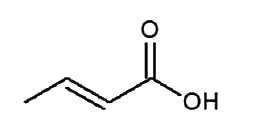H−C≡C−HHgSO4−−−−−−→H2SO4dil.NaOH−−−−−→Δ−−→P. The final product P is




The correct Answer is:B
To solve the problem step by step, we will analyze the reaction of the given compound and determine the final product P.
Step 1: Identify the Starting Compound
The starting compound is acetylene, represented as H−C≡C−H.
Step 2: Reaction with H2SO4 and HgSO4
When acetylene reacts with H2SO4 in the presence of HgSO4, it undergoes hydration to form vinyl alcohol (also known as ethenol), which can be represented as:
CH2=CHOH
However, vinyl alcohol is not stable and will undergo tautomerization to form acetaldehyde:
CH2=CHOH→CH3CHO
So, the compound A formed is acetaldehyde (CH3CHO).
Step 3: Reaction with Dilute NaOH
Next, acetaldehyde (CH3CHO) reacts with dilute NaOH. This reaction is an aldol condensation where two molecules of acetaldehyde react. The mechanism involves the formation of an enolate ion, which then attacks another molecule of acetaldehyde:
1. The base NaOH abstracts a proton from the alpha carbon of acetaldehyde, forming an enolate ion.
2. This enolate ion then attacks the carbonyl carbon of another acetaldehyde molecule.
The product formed from this reaction is a beta-hydroxy aldehyde, which can be represented as:
CH3−CH(OH)−CH2−CHO
Step 4: Dehydration of the Beta-Hydroxy Aldehyde
The beta-hydroxy aldehyde undergoes dehydration (loss of water) when heated, resulting in the formation of a conjugated enone. The dehydration leads to the formation of:
CH3−CH=CH−CHO
This compound is but-2-enal (also known as crotonaldehyde).
Final Product
Thus, the final product P is but-2-enal, which can be represented as:
CH3−CH=CH−CHO
Summary of the Reaction
1. Acetylene (H−C≡C−H) reacts with H2SO4 and HgSO4 to form acetaldehyde (CH3CHO).
2. Acetaldehyde reacts with dilute NaOH to form a beta-hydroxy aldehyde.
3. The beta-hydroxy aldehyde undergoes dehydration to yield but-2-enal (CH3−CH=CH−CHO).
Final Answer
The final product P is but-2-enal.
---
The starting compound is acetylene, represented as H−C≡C−H.
When acetylene reacts with H2SO4 in the presence of HgSO4, it undergoes hydration to form vinyl alcohol (also known as ethenol), which can be represented as:
CH2=CHOH
However, vinyl alcohol is not stable and will undergo tautomerization to form acetaldehyde:
CH2=CHOH→CH3CHO
So, the compound A formed is acetaldehyde (CH3CHO).
Next, acetaldehyde (CH3CHO) reacts with dilute NaOH. This reaction is an aldol condensation where two molecules of acetaldehyde react. The mechanism involves the formation of an enolate ion, which then attacks another molecule of acetaldehyde:
1. The base NaOH abstracts a proton from the alpha carbon of acetaldehyde, forming an enolate ion.
2. This enolate ion then attacks the carbonyl carbon of another acetaldehyde molecule.
CH3−CH(OH)−CH2−CHO
The beta-hydroxy aldehyde undergoes dehydration (loss of water) when heated, resulting in the formation of a conjugated enone. The dehydration leads to the formation of:
CH3−CH=CH−CHO
This compound is but-2-enal (also known as crotonaldehyde).
Thus, the final product P is but-2-enal, which can be represented as:
CH3−CH=CH−CHO
1. Acetylene (H−C≡C−H) reacts with H2SO4 and HgSO4 to form acetaldehyde (CH3CHO).
2. Acetaldehyde reacts with dilute NaOH to form a beta-hydroxy aldehyde.
3. The beta-hydroxy aldehyde undergoes dehydration to yield but-2-enal (CH3−CH=CH−CHO).
The final product P is but-2-enal.
Similar Questions
C6H5−C≡C−CH3HgSO4−−−→H2SO4A
View SolutionConsider the following reaction sequence,
CH3C≡CHaq.H2SO4−−−−−→HgSO4APCl5−−→HeatB
The products (A) and (B) are, respectively,
View SolutionC2H2Hg(OH)21%−−−−−−−−−−→H2SO4A[O]−−→B, B is :
View SolutionC2H4Br2−−→XKCN−−→Y,Y is
View SolutionSOCl2−−−→(A)KCN−−→(B)H+−−→(C ), the compound (C ) is

View SolutionWrite structures of compounds A,B and C in each of the following reactions:
(i) C6H5BrMg/dry ether−−−−−−−→A(a)CO2(g)−−−−−−−→(b)H3O+BPCl5−−→C
(ii) CH3CN(a)SnCl2/HCl−−−−−−−−−→(b)H3O+Adil.NaOH−−−−−→BΔ−−→C
View SolutionCH≡CHHgSO4−−−→H2SO4(X)LiAIH4−−−−→(Y)P4/Br2−−−−→(Z)
In this sequence of reaction, the (Z) is:
View Solution Hdil NaOH−−−−→[A]H2O+−−−→Δ[B]
Hdil NaOH−−−−→[A]H2O+−−−→Δ[B]
View SolutionThe product D of the reaction CH3ClKCN−−→(A)H2O−−→(B)NH3−−→(C)Δ−−→(D) is
View Solution_S01_475_Q01.png) Conc.H2SO4−−−−−−−→(A)
Conc.H2SO4−−−−−−−→(A)
View Solution
